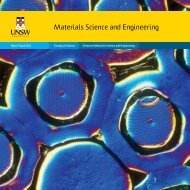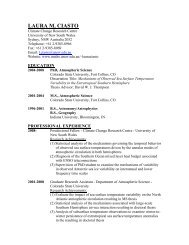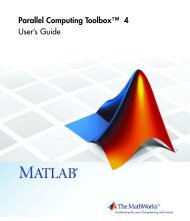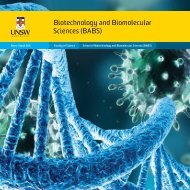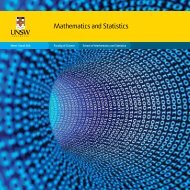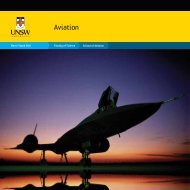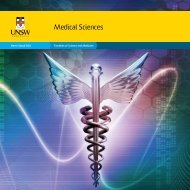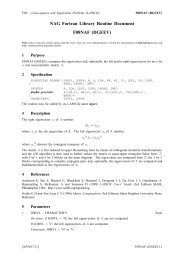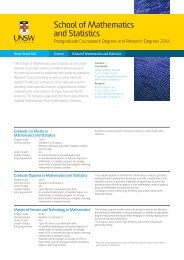2011 Postgraduate Research Competition - UNSW Science - The ...
2011 Postgraduate Research Competition - UNSW Science - The ...
2011 Postgraduate Research Competition - UNSW Science - The ...
Create successful ePaper yourself
Turn your PDF publications into a flip-book with our unique Google optimized e-Paper software.
Page |48<br />
Urinary Bladder Matrix in Conjunction with Laser<br />
Activated Chitosan-Based Bioadhesive for<br />
Sutureless Nerve Repair<br />
Tania Ahmed and John Foster<br />
School of Biotechnology & Biomolecular <strong>Science</strong>s<br />
Abstract<br />
Biocompatibility of biomaterial-based scaffolds is pivotal for successful tissue repair and<br />
reconstruction in tissue engineering applications, particularly in spinal cord injuries. In vivo<br />
implantation of a potential biomaterial may trigger irreversible host immune responses<br />
leading to loss of function and impaired healing. Suitable biomaterials that can serve as<br />
nerve conduits for transplanting olfactory ensheathing cells (OECs) into damaged spinal<br />
cord to induce nerve repair and regeneration are required. Consequently, this study<br />
incorporated extracellular matrix derived from porcine urinary bladder (UBM), which has<br />
been shown to facilitate the recruitment of marrow-derived stem cells, with SurgiLux, a<br />
chitosan-based laser activated adhesive to potentially fabricate a therapeutic scaffold for<br />
sutureless nerve repair. Furthermore, this study examined the influence of incorporated UBM-<br />
SurgiLux® biomaterials on OECs at the cell-material interface by adopting a cell cycle,<br />
apoptosis and proteomics approach.<br />
Cellular response at the material interface revealed a normal maintenance of regular<br />
morphology and enhanced growth of OECs compared to chitosan films alone. Cell cycle<br />
analysis revealed a significant difference in the DNA content of cell populations cultivated in<br />
the presence and absence of UBM-SurgiLux® films. Additionally, detection of early stage of<br />
apoptosis using Annexin V assay revealed significant deviations from standard culturing<br />
conditions as chitosan induced cell population to undergo early apoptotic activation. <strong>The</strong>se<br />
results provide new insights into the nature of OECs and their response to their<br />
microenvironment which is of paramount significance for the success of UBM-SurgiLux®<br />
biomaterials that promote regeneration of neural tissue.<br />
science + society |



